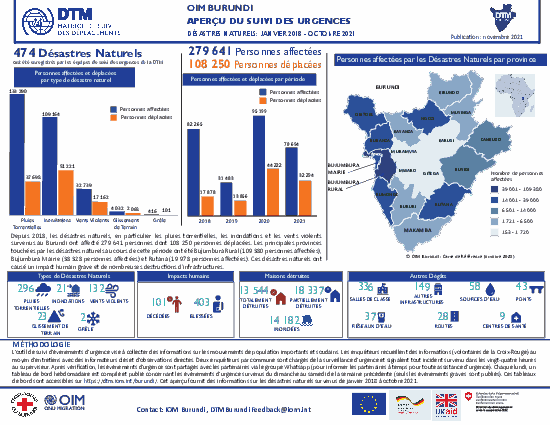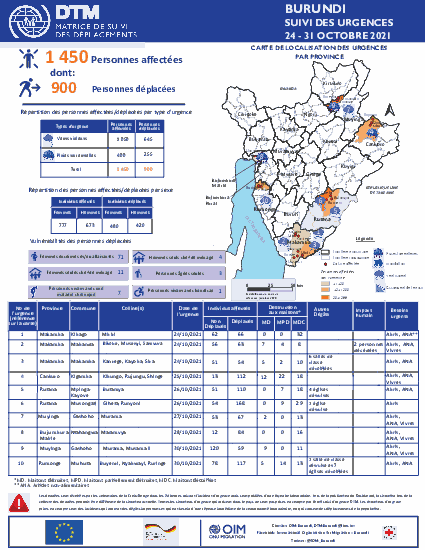-
Countries
-
Data and Analysis
-
Special Focus
-
Crisis Responses

Contact
DTM DRC, iomdrmrdc@iom.int
Language
English
Location
Democratic Republic of the Congo
Period Covered
Sep 01 2021
Sep 30 2021
Activity
- Mobility Tracking
- Baseline Assessment
Ce tableau de bord présente les principaux résultats de suivi de mouvement de la population dans la province du Tanganyika à l’issue du sixième cycle d’évaluation conduit par l’unité DTM de l’OIM. Ces évaluations ont été réalisées à travers un exercice de collecte de données conduit du 3 août au 1 septembre 2021, en collaboration avec l’ONG locale Promotion de Développement Humain et Protection De l’Environnement Social (PDHPES) et la Division Provinciale des Affaires Humanitaires (DIVAH Tanganyika). Lors de ce cycle, un total de 4 601 villages, couvrant 11 zones de santé (ZS), ont été évalués à la suite de consultations menées auprès de 13 851 informateurs clés.

Contact
DTM Burundi, DTMBurundi@iom.int
Language
French
Location
Burundi
Period Covered
Nov 08 2021
Nov 14 2021
Activity
- Event Tracking
- Mobility Tracking
La DTM a identifié 937 personnes (194 ménages) affectées inclues 306 personnes déplacées (67 ménages) par des vents violents et pluies torrentielles dans les provinces de Bubanza, Cankuzo, Muyinga et Ruyigi.

Contact
DTMMozambique@iom.int
Language
English
Location
Mozambique
Period Covered
Nov 04 2021
Nov 08 2021
Activity
- Event Tracking
- Mobility Tracking
From 4-8 November, DTM teams observed the arrival of 2,159 IDPs, in transit, reporting their intention to return to their places of origin in Palma district. According to reports received from arrivals in Vila de Mueda, the majority of the intended returnees are coming from the Ntele Relocation site in Montepuez district. Of these recorded movements, children constitute the majority of the travellers (46%). An estimated 31 elderly travellers were additionally reported within these observed movements.

Contact
DTM Uganda, dtmuganda@iom.int
Language
English
Location
Uganda
Period Covered
Oct 01 2021
Oct 31 2021
Activity
- Mobility Tracking
A total of 29,833 persons (44% male and 56% female) representing 5,719 households were affected by landslides (Bududa), floods (Kapelabyong, Napak, Obongi…), heavy storms/hailstorms (Masaka, Busia & Sironko) and earthquake (Western region – Kasese). 54% were children with age <18, 54% were adults (19-64 age) and 8% were elderly persons (>65 age). Internally displaced persons (IDPs) by disasters were 2,819 from 471 households and 331 were identified as persons with specific needs(PSN).
High priority needs in the affected districts include NFIs, water supply, food assistance, sanitation, hygiene promotion, health, shelter, and nutrition among others.
There were no other major disaster events reported from other districts and the infographic sheet only presents information received from represented districts.

Contact
DTMMozambique@iom.int
Language
English
Location
Mozambique
Period Covered
Oct 27 2021
Nov 04 2021
Activity
- Event Tracking
- Mobility Tracking
During the reporting period (27 October to 02 November 2021), a total of 65 movements were recorded - 30 arrivals (2,565 individuals), 22 departures (307 individuals), 7 transits (525 individuals), and 6 returns (196 individuals), Most arrivals were recorded in Mueda (1,158 individuals), Nangade (1,101 individuals), Montepuez (178 individuals) and Ibo (114 individuals). The largest departure was recorded in Montepuez (108 individuals). All intended return movements were observed from Montepuez (196 individuals). An estimated 31% of the population was displaced for the first time. Approximately 69% of reported IDPs were displaced more than once prior to this latest movement

Contact
DTM Burundi, DTMBurundi@iom.int
Language
French
Location
Burundi
Period Covered
Jan 01 2018
Oct 31 2021
Activity
- Event Tracking
- Mobility Tracking
Durant cette période, les équipes d'urgence de la DTM ont identifié 474 évènements d'urgence (pluies torrentielles, inondations, vents violents, glissement de terrain et grêle) qui ont affecté plus de 279 000 personnes incluses plus de 108 000 personnes déplacées. Ces désastres naturels ont causé la destruction de plusieurs maisons et autres infrastructures. Les provinces les plus affectées étaient Bujumbura Rural et Bujumbura Mairie.
Contact
DTMDRC@iom.int
Location
Democratic Republic of the Congo
Activity
- Mobility Tracking
- Baseline Assessment
Period Covered
Aug 03 2021 -Sep 01 2021
A baseline assessment is a sub-component of mobility tracking. It aims to collect data on IDP, migrant or returnee population presence in a defined administrative area of the country.
Population Groups
Survey Methodology
Unit of Analysis Or Observation
Type of Survey or Assessment
Keywords
Geographical Scope
Administrative boundaries with available data
The current dataset covers the following administrative boundaries

Contact
DTMMozambique@iom.int
Language
English
Location
Mozambique
Period Covered
Oct 20 2021
Oct 26 2021
Activity
- Event Tracking
- Mobility Tracking
During the reporting period (20 to 26 October 2021), a total of 58 movements were recorded - 13 returns (909 individuals), 19 arrivals (544 individuals), 21 departures (268 individuals), and 5 transits (267 individuals), The largest returns were recorded in Nangade (743 individuals), and Mueda (104 individuals). The largest arrival was recorded in Nangade (425 individuals). The largest departure was recorded in Chiure (112 individuals). Less than half of the population (22%) were displaced for the first time. An estimated 78 per cent of reported IDPs had been displaced more than once prior to this latest movement.

Contact
DTM Burundi, DTMBurundi@iom.int
Language
French
Location
Burundi
Period Covered
Oct 24 2021
Oct 31 2021
Activity
- Event Tracking
- Mobility Tracking
Durant la semaine du 24 au 31 Octobre, 400 personnes ont été touchées par des pluies torrentielles (255 personnes déplacées) et 1050 personnes affectées par des vents violents (645 personnes déplacées).

Contact
DTM Mozambique, DTMMozambique@iom.int
Language
English
Location
Mozambique
Period Covered
Sep 14 2021
Oct 01 2021
Activity
- Mobility Tracking
- Site Assessment
From 14 September to 1 October 2021, in close coordination with Mozambique’s National Institute for Disaster Management and Risk Reduction (INGD) of Manica and Sofala, the International Organization for Migration (IOM)’s Displacement Tracking Matrix (DTM) teams conducted Multi-Sectoral Location Assessments (MSLA) in 72 sites hosting 109,275 internally displaced persons (IDPs) - 83,018 in Sofala and 26,257 in Manica - in response to the mass displacements caused by Tropical Cyclone Idai, Tropical Cyclone Eloise, Tropical Storm Chalane, floods, violence and insecurity in the Central region, and the conflict in Cabo Delgado. Of the total 109,275 individuals in the assessed sites, 26,331 (or 24%) are women, 23,673 (22%) are men, and 59,271 (54%) are children. Demographic data in Figures 2 and 3 is a sample collected through random sampling of twenty households per site.